



“From the corner of the divan of Persian saddle-bags on which he was lying, smoking, as was his custom, innumerable cigarettes, Lord Henry Wotton could just catch the gleam of the honey-sweet and honey-coloured blossoms of a laburnum, whose tremulous branches seemed hardly able to bear the burden of a beauty so flamelike as theirs; and now and then the fantastic shadows of birds in flight flitted across the long tussore-silk curtains that were stretched in front of the huge window, producing a kind of momentary Japanese effect, and making him think of those pallid, jade-faced painters of Tokyo who, through the medium of an art that is necessarily immobile, seek to convey the sense of swiftness and motion.” – Chapter 1, The Picture of Dorian Gray, Oscar Wilde
Ricketts stated that the unusual and influential design of the book was in the style of an Aldine italic volume and a Persian saddle-book. 25 numbered …

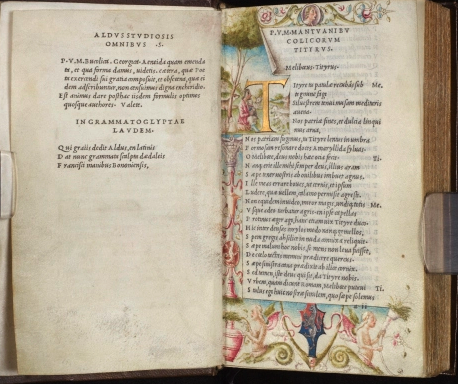

The John Rylands Library copy of the Aldine Virgil, printed on vellum, and illuminated with the coat of arms of the Pisani family of Venice. In the poem on the left page facing Virgil’s text Aldus praised the skill of the punchcutter Francesco Griffo of Bologna who designed the new Italic type. This type, based o the Italian humanist cursive script or Cancellersesca originally developed in the 1420s by the humanist and Niccolò de’ Niccoli, became the model for later Italic types
In April 1501 Venetian scholar printer Aldus Manutius issued an edition of the poems of Virgil (Vergil) in Italic typeOffsite Link designed by the punchcutter Francesco GriffoOffsite Link, also known as Francesco da Bologna. A very skilled craftsman, Griffo was also a “tumultuous character” who ended his life in the hangman’s noose for murdering his son-in-law. This was the first book completely printed in Italic typeOffsite Link, an adaptation of humanist script, possibly Aldus’s own handwriting. Facing the first page of Virgil’s text, Aldus included a poem praising the skill of Griffo who designed the new type. In addition to its elegant design, Italic type had the advantage of a higher character count, allowing more information to be printed legibly in less space than Roman or Gothic type.
Aldus’s edition of Virgil was also the first of a series of volumes that he issued in the pocket, or octavo format. This smaller format had previously been used for editions of devotional texts, but Aldus was the first to use the smaller format to make non-devotional literature available in the more portable format, and at lower cost. Davies pointed out that a signifcant reason for Aldus’s introduction of the octavo format was the collapse of the credit market in Venice in 1500 caused by “Venetian defeats and Turkish advances,” which caused many business failures, and would have motivated Aldus to publish books that could be sold at lower cost.
Walter Pater
Walter Pater: Individualism and Aesthetic Philosophy, By Kate Hext Edinburgh University Press 2013
“Symbolism in British ‘Little Magazines’: The Dial (1889–7), The Pageant (1896–7), and The Dome (1897–1900),” David Peters Corbett
https://doi.org/10.1093/acprof:osobl/9780199654291.003.0007
Pages 101–119, Published: May 2013
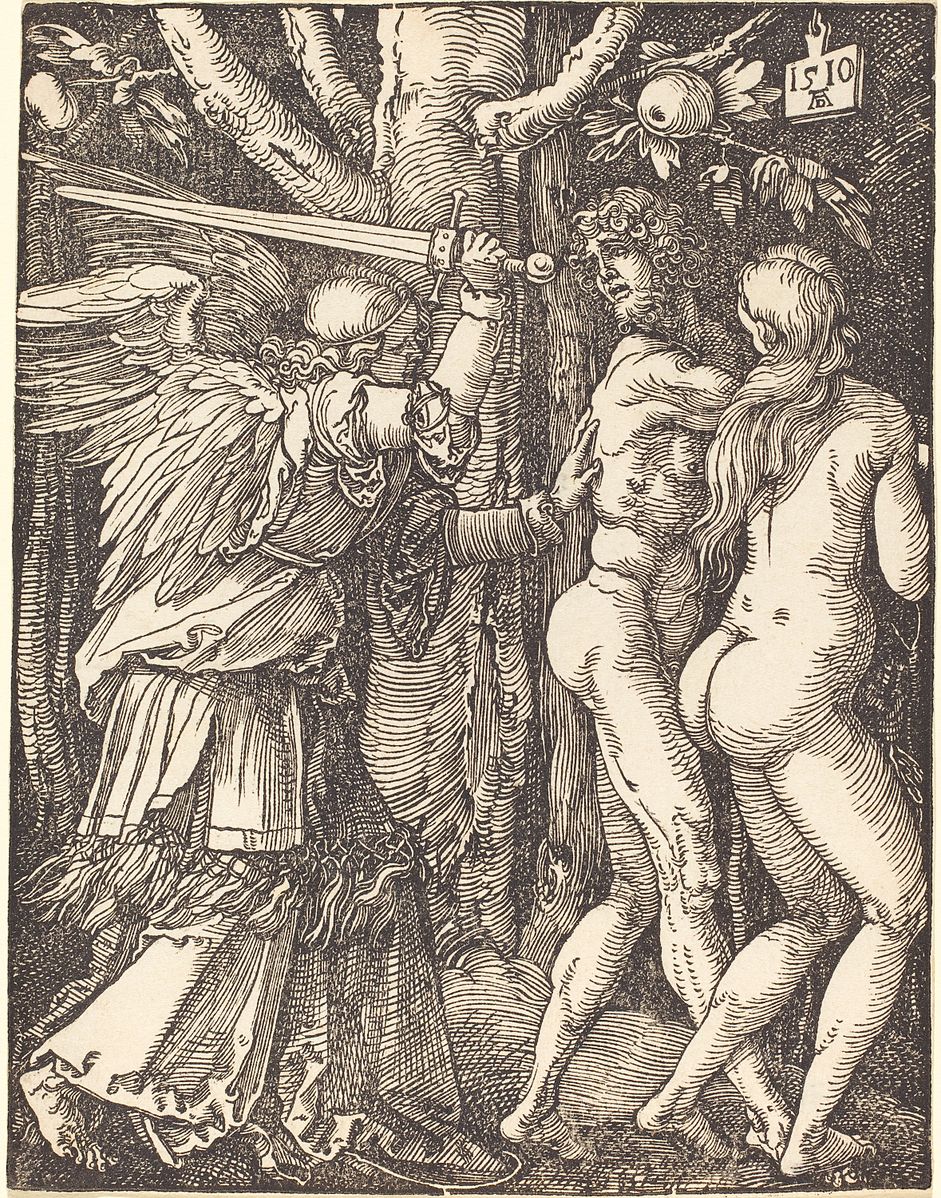
Albrecht Dürer 21 May 1471 – 6 April 1528), sometimes spelled in English as Durer, was a German painter, printmaker, and theorist of the German Renaissance. Born in Nuremberg, Dürer established his reputation and influence across Europe in his twenties due to his high-quality woodcut prints. He was in contact with the major Italian artists of his time, including Raphael, Giovanni Bellini, and Leonardo da Vinci, and from 1512 was patronized by Emperor Maximilian I.
Dürer’s vast body of work includes engravings, his preferred technique in his later prints, altarpieces, portraits and self-portraits, watercolours and books. The woodcuts series are more Gothic than the rest of his work. His well-known engravings include the three Meisterstiche (master prints) Knight, Death and the Devil (1513), Saint Jerome in his Study (1514), and Melencolia I (1514). His watercolours mark him as one of the first European landscape artists, while his woodcuts revolutionised the potential of that medium.
Dürer’s introduction of classical motifs into Northern art, through his knowledge of Italian artists and German humanists, has secured his reputation as one of the most important figures of the Northern Renaissance. This is reinforced by his theoretical treatises, which involve principles of mathematics, perspective, and ideal proportions.
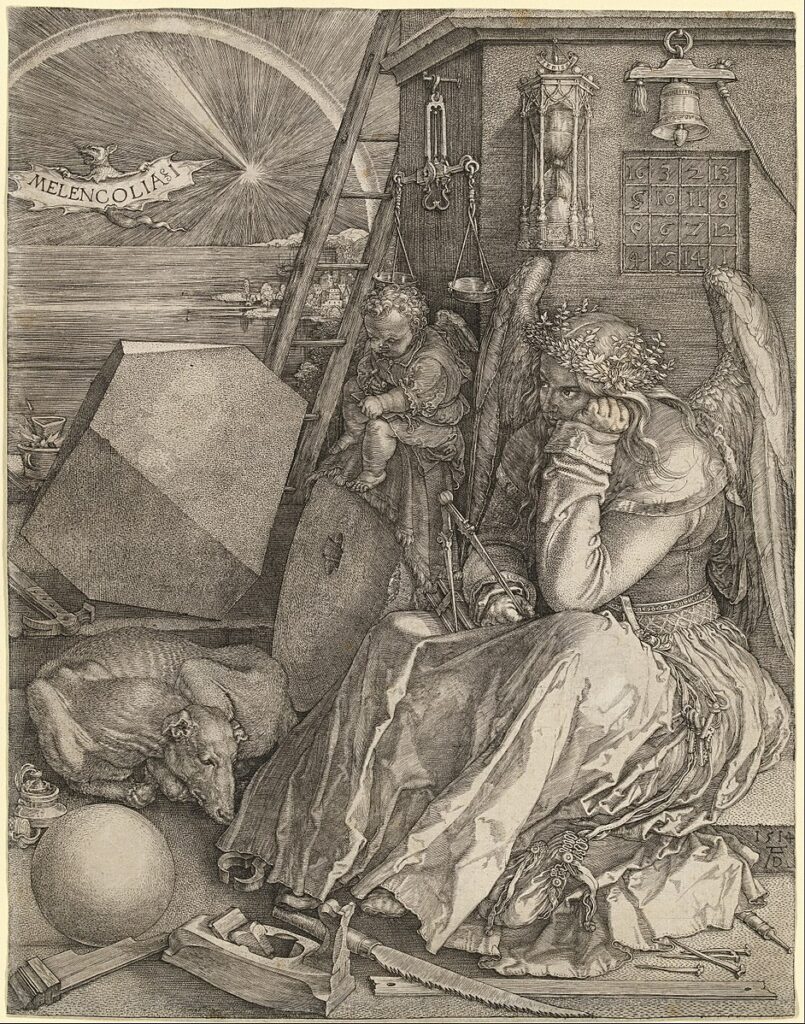
Melencolia, copper engraving, 1514
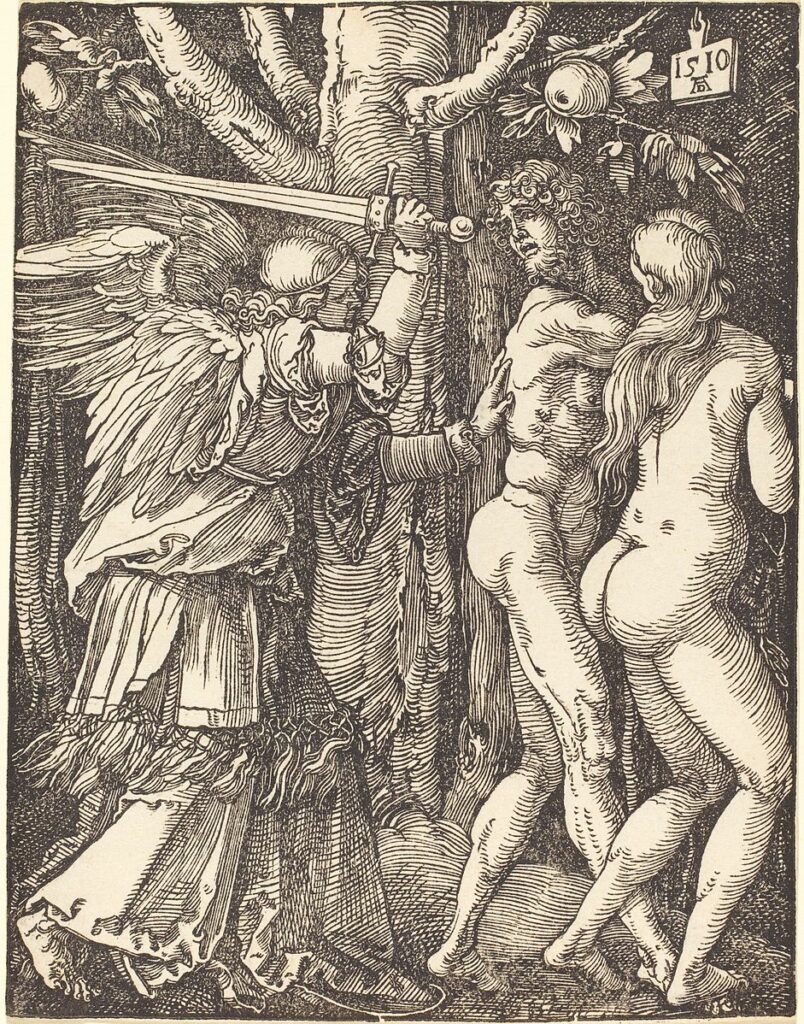
The Expulsion from Paradise, from The Small Passion, woodcut print, 1510

Biblia latina, commonly known as the Gutenberg Bible. (Mainz, Germany: Johann Gutenberg and Johann Fust, between 1454 and 1456)
In Mainz, Germany, in the mid-1450s, Johann Gutenberg and his partner Johann Fust published more than 150 large-format copies of the Bible in Latin. This is the book known today as the Gutenberg Bible. Gutenberg may have begun developing a new printing technology as early as the 1430s, and completion of the Bible demonstrated the viability of a press that used individual pieces of metal type to mass-produce books. Although books would continue to be written by hand in the years— and centuries—that followed, the printing process pioneered by his team became increasingly prevalent, helping change how information traveled in Europe and, later, the world.
The Ransom Center’s copy represents one of only 20 complete copies in the world that survive intact. Printed on paper, the two volumes remain in early bindings and feature text and decoration added by hand. In the first volume, books of the Bible begin with two types of distinctive, colorful letters. The second volume features more traditional red and blue initials. Acquired in 1978, this Gutenberg Bible is always on view and can be accessed in its entirety below.
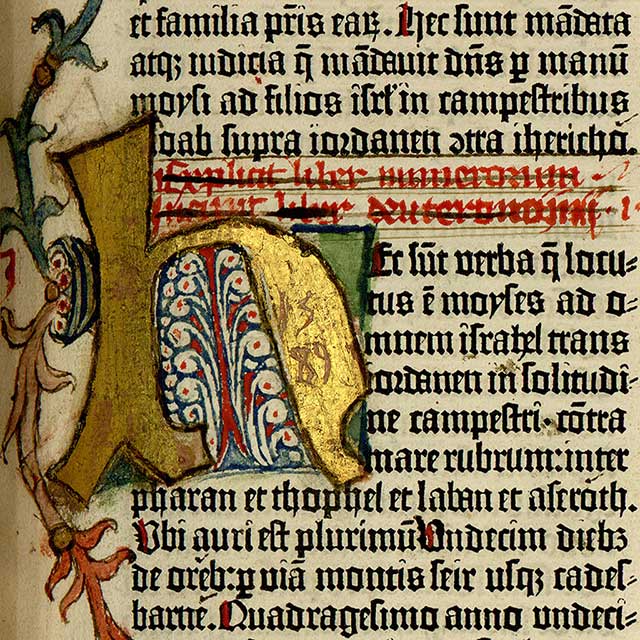
Biblia latina, commonly known as the Gutenberg Bible. (Mainz, Germany: Johann Gutenberg and Johann Fust, between 1454 and 1456)







Chancery 2° (268 x 191 mm). Collation: [1-1410 158 (1/1 blank removed, 1/2r title printed in red hEre begynneth the volume intituled and named the recuyell of the historyes of Troye, composed and drawen out of dyverce bookes of latyn into frensshe by … Raoul le ffevre. preest and chapelayn unto … Phelip duc of Bourgoyne of Braband etc In the yere … a thousand foure honderd sixty and foure, And translated and drawen out of frenshe into englisshe by Willyam Caxton mercer of ye cyte of London, at the comaundement of … Margarete … Duchesse of Bourgoyne … begonne in Brugis in the Countee of Flaundres the fyrst day of marche … a thousand foure honderd sixty and eyghte, And ended and fynysshid in the holy cyte of Colen the. xix. day of septembre … a thousand foure honderd sixty and enleven, 1/2v Caxton’s prologue, incipit: [W]Han I remembre that every man is bounden, 1/3v Le Fèvre’s prologue, incipit: Whan y behold and knowe the oppynyons of the men, 1/4v heading to bk. I printed in red The begynnyng of this book sheweth the Genelagye of Saturne, 1/5r text, incipit: What tyme alle the Children of Noe were sprad, 15/8v explicit: Thus endeth the first book of the recueyll or gadryng to geder of the historyes of Troye); 16-2410 258 266 (16/1r Hiere begynneth the seconde booke … that speketh of the prowesses of the stronge Hercules, 26/6r explicit, 26/6v blank); 27-3610 (27/1r In these two bokes precedente. we have … tretyd of the two first destruccyons of Troye … Now in the thirde and laste book god to fore. we shall saie how … the sayd cyte was totally destroyed, chapter-heading printed in red How the kynge Priant reediffied the cyte of troye, incipit: For to entre than in to the matere, 36/9r Caxton’s epilogue, incipit: Thus ende I this book whyche I have translated … myn eyen dimmed with overmoche loking on the whit paper … Therefore I have practysed and lerned at my grete charge and dispense to ordeyne this said book in prynte … and is not wreton with penne and ynke as other bokes ben, to thende that every man may have them attones. ffor all the bookes of this storye … thus enpryntid … were begonne in oon day, and also fynysshid in oon day, 36/10r Latin verse attributed to HILDEBERTUS (1st half 12th century, Archbishop of Tours), incipit: Pergama flere volo. fata danais data solo, 36/10v blank)]. 344 leaves (of 352; lacking the blank first leaf, sheet 2/1.10 and fos. 19/3-7 supplied in pen-and-ink facsimile by J. Harris at the time of rebinding); fo. 19/8 probably and fos. 1/2-3 just possibly supplied from another copy at the time of rebinding.
Paper from six different stocks, but there are two principal runs: the first from Piedmont with watermark of a bunch of grapes with looped stem (Stevenson/Briquet pl. *A3), the second from Vosges with bull’s head/Tau watermark (variant of Piccard II Abt. X 13-19); the rest are essentially stray sheets: w/m mermaid (Briquet 13859), arms of France, bull’s head/X, gothic P. The paper sequence seems to indicate that the edition, set in three composition units, was printed concurrently on two presses; a set of six pins kept the sheet in position over the forme (the four outermost pinholes are visible in the corners of most sheets, the central pair remains mostly but not always hidden in the gutter). Bastarda type 1:120, presumably cut and supplied by Johann Veldener. 31 lines. Title and two headings printed in red. Rubricated in an early hand: initials, paragraph marks, some capital strokes; 7-line initial W to start the text painted in liquid gold and outlined in red (probably somewhat later). Quiring in early manuscript. (Upper outer corner of title and following leaf torn away and restored with the missing text supplied in pen-facsimile; a few other repairs, mostly marginal, otherwise in unrestored condition; slight soiling in places and occasional minor stains, but the copy is unwashed and the paper fresh.) English gold-tooled binding by Charles Lewis, c.1833, blue morocco over heavy pasteboard, wide border on sides built up from small tools including flowers, crowns, acorns, stars and dots, compartments of spine decorated with the same tools and lettered, roll-tooled border on turn-ins, gilt edges.
Provenance: ?Agnes Cole 1518 (De Ricci 3.19), but there is no evidence for this ownership — Tresham family By me Thomas Trisham (inscription on final blank page), probably Sir Thomas Tresham of Rushton (fl. 1500, d. 1559, sheriff, MP for Northamptonshire); John Trishem (entry below the heading to bk. I), perhaps John Tresham of Rushton, Northants (d. 1546, son of Thomas); a signature that could be read as MA Tresham, perhaps Mary Tresham (d. 1597, John’s daughter) The Sir Thomas Wriothesley – King George III – B.L. copy of another Caxton translation, the second printed book in English (Bruges: 1474), Jacobus de Cessolis’ The Game and Play of Chess, was also owned by one of the Northamptonshire Treshams, very probably George Tresham, MP, who was probably in the household of Edward VI as prince. — John Skinner of Bristol (early inscription on 22/8v) — Delaroy (early inscription on 32/1r) — John Benet(?) (early inscription on 34/8v) — a variety of early English manuscript marginalia and calculations, including receipts of payment for wines naming a Mr. Smith and John Savery — Henry ?Sperke (ownership inscription in a late-16th/early-17th-century hand on b6v) — Beriah Botfield, purchased in 1833 from Payne and Foss for £168 (P. & F. Acquisitions p.77).
THE FIRST BOOK PRINTED IN ENGLISH AND THE FIRST PRODUCTION FROM CAXTON’S FIRST PRINTING SHOP. Caxton’s Bruges press was the second to be established in the Burgundian Netherlands after that of Johannes de Westfalia and Thierry Martens in Alost; the market for the Bruges printers (wealthy courtiers reading vernacular chivalric literature) was very different from that of the Alost and Louvain printers (cheap Latin texts for university readers). Le Fevre’s medieval version of the Trojan cycle is based more on Dictys (4th century), Dares (5th century), Benoît de Sainte-More (12th century) and Guido delle Colonne (13th century) than on Homer and also recounts at great length the exploits of Perseus and Hercules; he dedicated the work to Philip the Good, just as some years later his translator would dedicate it to Margaret, Duchess of Burgundy.
Before England’s first printer set up shop in 1476 within the precincts of Westminster Abbey, he had been active on the continent as merchant, diplomat, translator, publisher and printer. It was during his semi-exile in Cologne that Caxton was first confronted with the newly invented art of printing. In 1471-72 he commissioned from a local press, run by Johann Schilling, three Latin books of English origin (VK 296, VK 218, VK 501 in that order, see P. Needham, “William Caxton and his Cologne partners,” in: Ars Impressoria, Festgabe für Severin Corsten, 1986, p. 103-131), and there he met the typefounder and printer Johann Veldener, who later supplied the first type to be set in England. Also while in Cologne, the wealthy entrepreneur from Kent finished the translation of the Recueil des histoires de Troie, his first great literary effort, with which he had persisted since 1468 at the command of Margaret of York, sister of Edward IV of England and wife of Charles the Bold of Burgundy. Caxton then returned to Bruges where he printed at least six books (2 in English, 4 in French), starting off with the Recuyell.
Eighteen copies are extant, only two of which are complete (British Library, Morgan Library). The most important surviving copy is in the Huntington Library (ex-Roxburghe-Chatsworth), with the unique dedication engraving inserted. Five other copies remain in private hands (Marquess of Bath [Sir John Thynne’s copy, at Longleat since no later than the 1540s], Paul Mellon, Scheide Library, Duke of Northumberland, Fitzwilliam [not in De Ricci, sold Christie’s, 8 July 1998, lot 1]). Very small fragments are located in four American (3 originally belonging to the same copy; the Robert Taylor fragment at Princeton not in De Ricci) and four English libraries. The only (and excellent) census was published in 1909 by Seymour de Ricci. Since then the following changes of ownership have occurred: DeR 3.5 Cambridge UL now Paul Mellon, 3.10 Sion College now Keio University, Japan, 3.11 Duke of Devonshire now Huntington Library, 3.12 Earl of Pembroke now Texas UL, 3.13 J. Pierpont Morgan now Scheide Library, 3.16 Fitzroy Fenwick now Duke of Northumberland; 3.19 “owner untraced” is the copy here offered for sale; 3.25 one of the four sets of 2 ff. “untraced” now Yale UL. The only copy located outside England and the United States is in Paris B.N., lacking 52 leaves (DeR 3.9).
Literature: Ames-Herbert I, p. 5-9; Ames-Dibdin I, p. 16-28; HC 7048; Blades 1; CA (I) and KC II 1093a; Pr 9322; A.W. Pollard, Morgan 634; Duff 242; STC 15375; Pforzheimer 594; Oates 3837-8; BMC IX, 129 (IB. 49431); Goff L-117; Cinquième Centenaire 82; Blake (1976) pp. 107-108, 197; Painter pp. 45-48, 51-54, 59-64; Hellinga (1982) pp. 29-31, 48; CIBN L-83; Needham (1986) Appendix D, Cx 4 (incorr. coll.).

AUGUSTINUS, Aurelius (354-430, Saint). De civitate dei. Rome: Conradus Sweynheym and Arnoldus Pannartz, 1470.


Super-median 2o (370 x 240 mm). Collation: [1-28 3-510 6-88 9-1110 12-148 15-1810 19-208 21-2310 24-268 27-2810 2912 3010 318 3210]. 290 leaves (of 294; without the 4 blanks). 46 lines. Roman type 2:115. Rubricated in alternate red and blue, initials with delicate pen-flourishing, book numbers supplied in red in upper margin. FLORAL-PAGE BORDER incorporating 15-line initial I and 9-line initial G, illuminated in gold and colors by a contemporary hand, and 21 other illuminated initials. (Repaired tear on 1/2 touching letters, small marginal repair on 3/1 affecting border, 26/6-7 with small stain in lower margin, some worming catching letters, heaviest at end, occasional mostly marginal spotting, a few book numbers shaved.) 19th-century panelled vellum gilt over wooden boards, morocco lettering-pieces. Provenance: “Pertinet ad locum Crucis Calle Caserte” (inscription on 1/2) — Alexander James Beresford Hope (1820-1887), English politician, author and ecclesiatical historian (gift inscription, dated St. Peter’s Day, 1848, on front flyleaf, presenting the book to) — Rev. E. Coleridge — C.W. Dyson Perrins (booklabels; sold Sotheby’s London, 17 June 1946, lot 30 to Maggs Bros., London, for £300) — Estelle Doheny (morocco bookplate; purchased from Maggs Bros.) — donated to SMS 12 September 1947.
THE FINE DYSON PERRINS COPY. Third (second Roman) edition. After having established a press at the Benedictine monastery at Subiaco, Sweynheym and Pannartz moved their second printing shop to Rome in 1467 at the Palazzo Massimo, most likely at the behest of the great humanist, Cardinal Bessarion. Bessarion’s secretary, Giovanni Andrea Bussi, soon became chief editor of the press (and later papal librarian), directing its printing program of humanistic texts. Sweynheym and Pannartz had already printed the first edition of De Civitate Dei at Subiaco in 1467 (Goff A-1230), and again in Rome in 1468 (Goff A-1231).
“Few men have influenced human thought as Augustine did Western religion and philosophy” (DSB). Written as a defence of Christianity against pagan critics who viewed the sack of Rome as punishment for the abandonment of the old gods, Augustine’s magnum opus presented a dialectical view of human history that profoundly marked Western thought. BMC IV, 10 (IC.17149); BSB-Ink. A-854; GW 2876; HC *2049; Pollard Perrins 3 (this copy); Pr 3310; Goff A-1232.
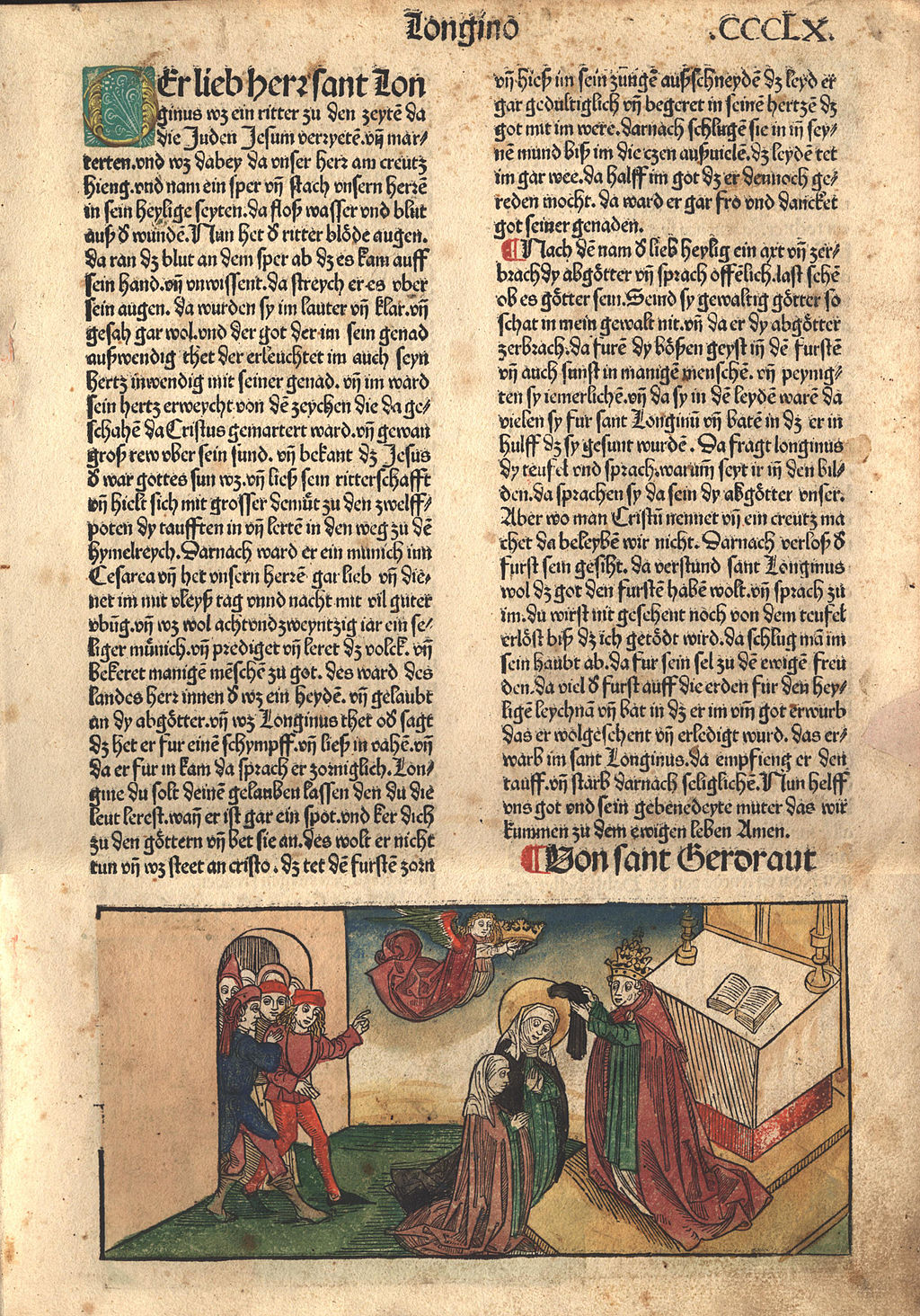
Anton Koberger[1] (c. 1440/1445 – 3 October 1513) was the German goldsmith, printer and publisher who printed and published the Nuremberg Chronicle, a landmark of incunabula, and was a successful bookseller of works from other printers. In 1470 he established the first printing house in Nuremberg. Koberger was the godfather of Albrecht Dürer, whose family lived on the same street.
Of Koberger’s many different printed editions which he produced from the late 15th century to the early 16th century, three stand out in particular. He printed an illustrated edition of the Bible in High German in 1483, complete with many remarkable woodcut illustrations. The text is from the first German Bible printed by Günther Zainer in the 1470s.
oberger also printed an edition of the Golden Legend by Jacobus de Voragine in German in 1488, also illustrated with woodcuts of saints and religious themes.[7] His most celebrated project is the so-called Nuremberg Chronicle of 1492, or Liber Chronicarum, probably the most extensively illustrated edition of the incunabula period, c. 1450–1500. Editions were produced in both Latin and German. The work was so popular, it is believed by scholars to have had one of the largest print-runs of the Incunabula Period. Because of the popularity, pirated editions appeared almost immediately after Koberger’s edition.[8]

Folio Page from “The Golden Legend” printed by Anton Koberger, 1488. The image depicts a saintly woman being anointed, possibly St. Mary or any number of other female saints.

A page from the Nuremberg Chronicle, leaf 25 (page 49) printed by Anton Koberger circa 1492.
Peter Schöffer or Petrus Schoeffer (c. 1425 – c. 1503) was an early German printer, who studied in Paris and worked as a manuscript copyist in 1451 before apprenticing with Johannes Gutenberg and joining Johann Fust, a goldsmith, lawyer, and money lender.[1]
Among his best-known works are the 1457 Mainz Psalter, the 1462 Bible or Biblia pulcra, and the 1484 Herbarius latinus.